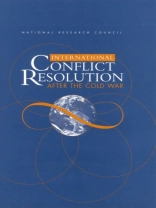The end of the Cold War has changed the shape of organized violence in the world and the ways in which governments and others try to set its limits. Even the concept of international conflict is broadening to include ethnic conflicts and other kinds of violence within national borders that may affect international peace and security. What is not yet clear is whether or how these changes alter the way actors on the world scene should deal with conflict: Do the old methods still work? Are there new tools that could work better? How do old and new methods relate to each other?International Conflict Resolution After the Cold War critically examines evidence on the effectiveness of a dozen approaches to managing or resolving conflict in the world to develop insights for conflict resolution practitioners. It considers recent applications of familiar conflict management strategies, such as the use of threats of force, economic sanctions, and negotiation. It presents the first systematic assessments of the usefulness of some less familiar approaches to conflict resolution, including truth commissions, "engineered" electoral systems, autonomy arrangements, and regional organizations. It also opens up analysis of emerging issues, such as the dilemmas facing humanitarian organizations in complex emergencies. This book offers numerous practical insights and raises key questions for research on conflict resolution in a transforming world system.
Commission on Behavioral and Social Sciences and Education & Committee on International Conflict Resolution
International Conflict Resolution After the Cold War [PDF ebook]
International Conflict Resolution After the Cold War [PDF ebook]
Mua cuốn sách điện tử này và nhận thêm 1 cuốn MIỄN PHÍ!
Ngôn ngữ Anh ● định dạng PDF ● Trang 640 ● ISBN 9780309501279 ● Biên tập viên Daniel Druckman & Paul C. Stern ● Nhà xuất bản National Academies Press ● Được phát hành 2000 ● Có thể tải xuống 3 lần ● Tiền tệ EUR ● TÔI 7145824 ● Sao chép bảo vệ Adobe DRM
Yêu cầu trình đọc ebook có khả năng DRM












